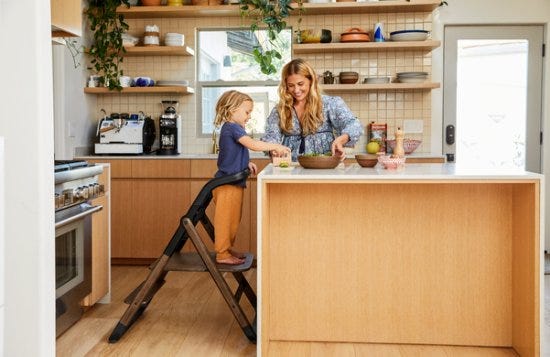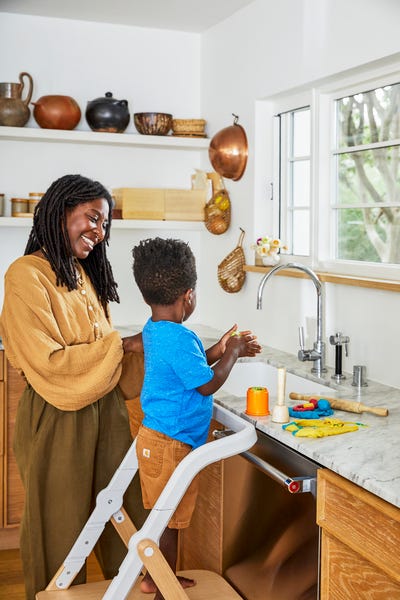Mealtime Bonding: Fun Activities to Enhance Family Dinners

Family dinners are more than just a routine gathering; they are fundamental to a family’s bond and emotional well-being. Studies have shown that sharing meals can greatly improve family bonds and offer a regular opportunity for communication. According to research published by the American Academy of Pediatrics, children who share meals with their families three or more times a week are more likely to exhibit healthy eating habits, perform better academically, and experience fewer behavioral problems. These fun family meals provide a setting for daily communication, helping family members of all ages feel more connected and supported.
A study from Harvard Health Publications also highlights that eating together not only strengthens family bonds but also encourages healthier dietary choices. During these meals, parents can model healthy eating habits, discuss the day's events, and address any concerns their children might have, contributing to better emotional health and resilience.
By prioritizing mealtime as a time for family bonding, parents can create a nurturing environment that fosters communication and supports the overall development of their children. We know that especially with younger kids, mealtimes can often be a bit chaotic. Thankfully, no one is expecting perfection, just connection! This blog explores how to elevate these moments around the table!

Setting the Stage for Bonding
Creating a healthy dining environment starts with removing distractions like TVs and phones. Even toys at the table can be an unwelcome distraction. If your kids are like my kids, they’d rather play than eat. And before you know it the toys are in the food and you’ve got a bigger mess on your hands.
Removing distractions applies to the adults at the table as well! Try leaving your phone in the other room so that you aren’t tempted to check notifications throughout dinner.
Having a seat that your kid fits in makes a huge difference too! Whether it’s a high chair or a toddler chair, having a place where your little one can sit tall at the table with their feet firmly planted helps them focus and engage in the meal at hand.
SHOP ERGOBABY Evolve high Chair
SHOP ERGOBABY Evolve Chair

Establishing Mealtime Routines
Regular family mealtimes are more than just a practice; they are a cornerstone of creating harmony and structure within the home. Establishing a consistent routine around dining can significantly benefit families, especially those with young children. Here are some practical suggestions for parents looking to cultivate a nurturing mealtime environment:
- Fixed Timing for Meals: Set specific times for dinner that work consistently with your family’s schedule. This predictability helps children feel secure and establishes a sense of normalcy and expectation. Young children, in particular, thrive on routine, as it helps them understand what to expect and when to expect it, reducing anxiety and resistance around mealtime.
- Preparation Together: Involve your children in meal preparation, tailored to their age and abilities. For toddlers, it could be as simple as washing vegetables or setting placemats on the table. This involvement helps them feel valued and part of the family team, and it can serve as a gentle transition into mealtime for those who might need a bit of extra encouragement to come to the table.
SHOP Kitchen Towers
- A Moment of Transition: Create a small ritual that signifies the start of mealtime. This could be ringing a bell, playing a particular song, or a simple group statement like "It's dinner time!" Such signals help children switch from playtime or screen time to mealtime, easing transitions and setting the tone for the meal.
- Designated Seating: Have specific seats for each family member. Consistent seating arrangements can provide a comforting predictability and a sense of ownership for young children. This also helps in managing dynamics between siblings and ensuring that each child has a space where they feel comfortable.
- No Distractions: Establish a no-electronics rule at the table to encourage conversation and engagement. This includes turning off the TV and putting away phones and tablets. For families with very young children, keeping toys and books away from the dining table can also help in focusing on the meal and family members.
- Post-Meal Routine: After dinner, involve the family in cleanup. Young children can clear their own plates or help wipe the table. Following cleanup, a family activity like a short walk or a group game can help end the evening on a high note, reinforcing the positive experience of family time.

By implementing these routines, parents can create a mealtime environment that nurtures both the body and the spirit of all family members. These practices are not only about feeding the physical body but also about nourishing the family’s emotional and social connections, providing a daily touchpoint that strengthens the family unit.
Conversation Starters for Family Dinners
Kickstart dinner conversations with questions that will encourage discussion rather than “yes or no” answers.
Here are some ideas:
- Daily Highs and Lows: We like to start our dinners with “high, low, buffalo” where everyone shares the high of their day, the low of their day, and something that was silly or made them smile. This simple question can lead to deeper conversations and helps children articulate their experiences and emotions.
- Observation Games: Adapt this to suit all ages by asking younger children to identify colors or shapes on the table, and challenge older kids with more abstract observations, like guessing which ingredients were used in the meal or discussing the origins of various dishes.
- Animal Sounds and Beyond: While younger children might enjoy making and guessing animal sounds, extend this to older children by turning it into a trivia game about animal facts, such as habitats or peculiar traits, sparking curiosity and learning.
- Story Starters: Start a story and go around the table adding to it. This can be tailored to the age of the children, with older kids being challenged to add more complex ideas or plot twists, fostering creativity and sequential thinking.
- Express and Reflect on Feelings: Ask questions like, "How did you feel during a specific event at school today?" or "What made you smile today?" This encourages children of all ages to reflect on their feelings and promotes emotional intelligence.
- 'Would You Rather' Questions: My family also loves “would you rather” questions. These can range from simple choices for younger kids to more complex dilemmas for older children, such as, "Would you rather have the ability to fly or be invisible?" Discussing their choices can lead to interesting insights into their personalities and values.
- Imaginary Scenarios: Encourage imaginative thinking by posing scenarios like, "If you could travel anywhere in the world, where would it be and why?" or "If you could invent something, what would it solve?" This helps older kids practice problem-solving and goal-setting.
- Historical What-Ifs: For families with older children, pose historical what-if scenarios, such as "What if the internet was invented 50 years earlier?" These discussions can enhance critical thinking and provide a fun way to learn history.
- Future Dreams: Ask your children, regardless of their age, about their dreams for the future. Discuss the steps they imagine taking to achieve these dreams. This conversation starter not only fuels ambition but also gives insight into what excites and motivates your child.

Dinner Table Games
Introduce fun table games that involve everyone, like trivia quizzes about family history, word games, or simple riddles. These family dinner games are great for laughter and learning, making dinner times lively and educational.
Cooking Together
Involving everyone in meal preparation is not just about cooking but also about spending quality time together. Often kids are more likely to try new foods when they were involved in making it. Experiment with new recipes, making cooking a learning experience for the kids with simple, fun recipes for dinner.
Ergobaby's Evolve Kitchen Tower can be a safe space for kids to join in at the counter for kitchen duty. The Kitchen Tower is a quick attachment for the Evolve High Chair System that allows the high chair to grow with your family. Make sure to use caution and safety and give your kids age-appropriate jobs in the kitchen.
SHOP Kitchen Towers
Theme Nights
Occasionally, plan a themed dinner night where everyone dresses up and the menu matches the theme—Italian, Mexican, or superhero night, anyone? My family did “Fancy Fridays” for a bit where we got dressed up in our nicest clothes. This can be a delightful way to teach kids about different cultures and cuisines in a fun, immersive way. It’s also a great way to switch things up to keep your kids engaged.
Gratitude and Reflection
Take time each meal to share something you’re grateful for. Reflect on the best parts of the day and discuss the plans for the coming days. It’s a calming way to finish the meal and helps to foster positivity within the family.
Creating Traditions
 Establishing fun family dinner traditions can have a profound impact on creating a sense of identity and belonging within the family unit. These traditions become cherished rituals that children and adults alike look forward to, strengthening family ties and creating lifelong memories. Here are some examples of family dinner traditions that you can consider integrating into your family life:
Establishing fun family dinner traditions can have a profound impact on creating a sense of identity and belonging within the family unit. These traditions become cherished rituals that children and adults alike look forward to, strengthening family ties and creating lifelong memories. Here are some examples of family dinner traditions that you can consider integrating into your family life:
- Sunday Suppers: Make Sunday night dinner a special family gathering where a more elaborate meal is prepared or a favorite family recipe is enjoyed. This weekly tradition gives everyone a set time to reconnect after a busy week and before another begins.
- Ethnic Nights: Rotate through different cuisines of the world on a monthly or weekly basis. Whether it’s Italian, Mexican, Japanese, or Indian night, each meal can be an opportunity to learn about different cultures through food, music, and decorations. This not only makes mealtime exciting but also educational.
- Birthday Choice: Let the birthday person choose the menu on their special day. This can be anything from their favorite home-cooked meal to takeout from a cherished restaurant. It’s a fun way to honor and celebrate each family member's individual tastes and preferences.
- Breakfast for Dinner: Pick a night of the week where you eat breakfast for dinner. This is a favorite in our home because who doesn’t love eating pancakes and bacon?!
- Theme Nights: Similar to breakfast for dinner, maybe you stick to Taco Tuesdays or Pasta Mondays. This kind of routine makes it easy on the parent for meal planning, but also creates a routine the kids can look forward to.
- Recipe Book: Start a family recipe book where everyone contributes their favorite recipes. Over time, this book will grow and serve as a valuable family heirloom that can be passed down to future generations. Make a habit of cooking from this book together on a regular basis, adding new favorites as they emerge.
By introducing fun activities and fostering an environment of engagement and gratitude, family dinners can become a foundational ritual for strong family relationships. Remember, it's not just about the food but the memories and bonds that are created around the table. Start tonight, and transform your mealtime into an exciting family bonding activity!





 Establishing fun family dinner traditions can have a profound impact on creating a sense of identity and belonging within the family unit. These traditions become cherished rituals that children and adults alike look forward to, strengthening family ties and creating lifelong memories. Here are some examples of family dinner traditions that you can consider integrating into your family life:
Establishing fun family dinner traditions can have a profound impact on creating a sense of identity and belonging within the family unit. These traditions become cherished rituals that children and adults alike look forward to, strengthening family ties and creating lifelong memories. Here are some examples of family dinner traditions that you can consider integrating into your family life:























